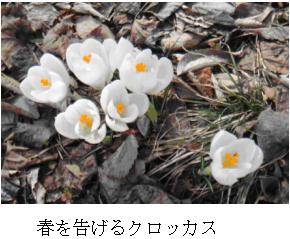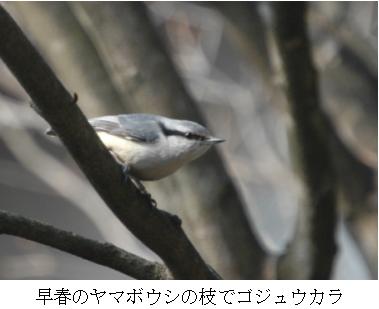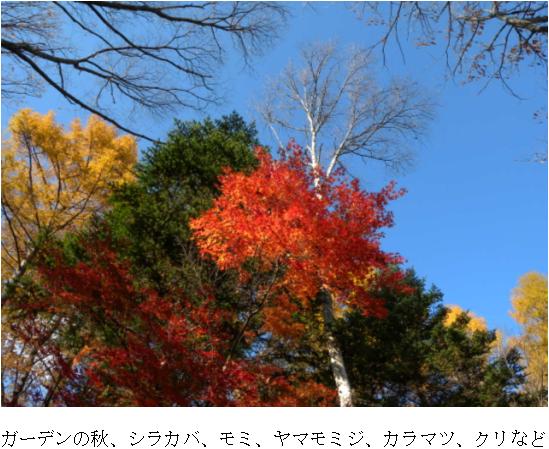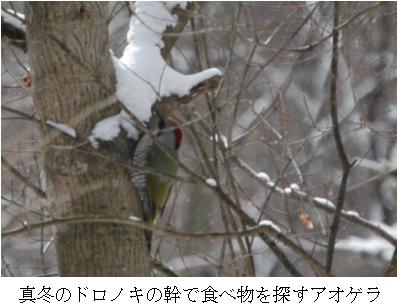
早春(といっても当地では4月ですが)、地面では落ち葉のふとんからクロッカスが頭をもたげて咲き、水仙の葉があちこちから剣先を出して合図するようになると、樹上でも固く結んでいた木の芽がわずかに緩んで、初々しい薄緑色が見えてきます。
暖かな日差しの中、ソフィアート・ガーデンの明るい広葉樹の下でフキノトウを摘んでいると、どこからかポタッ、ポタッ、と雫の落ちてくる音がします。
雨だろうか、とふと見上げて、青空を背景にすっきりと高く伸びる白い樹肌がその正体であることを思いだしました。ミズキです。この時期はミズキが「水木」であることを最も良く表す季節です。高い木の枝のあちらこちらから、ミズキが吸い上げた水の雫が落ちてきます。
こうなると、誰も季節の流れを止めることは出来ません。やがて何万、何億、何兆という葉っぱがすべての蕾からこぼれ出てきます。
落葉樹はまだ一枚の葉もなく、一見静かに眠っているようにも見えますが、よくよくじーっと見ていると、木の枝の隅々まで生命力を表す色が満ち、木の最も盛んな時期であることがわかります。私にはその色は、その木の紅葉や花の色に似ているように見えます。赤く紅葉する木は枝先が仄かに赤く、黄葉する木や黄色い花の咲く木は枝先に黄緑が浸透していくように見えます。

シラカバも、この時期さかんに水を吸い上げるため樹液採取をして飲む人もいると聞きます。シラカバの樹液はキシリトールとして有名です。ガーデンにも15メートルほどのシラカバをはじめ、7、8本のシラカバがありますが、ちょっと穴をあけるのには忍びなくて樹液を採取したことはありません。また、巨大なヤマボウシもありますが、ヤマボウシもミズキほど雫は落とさないものの、晴れた日には場違いの水が樹肌を濡らしているのを目にして少し驚くことがあります。ミズキやヤマボウシの樹液については、人間が飲んだりすることは聞いたことがありません。最もミズキなどは樹液がオレンジ色にべったりついているのを見ると、その樹液を飲んでみたいという考えは私にはまず浮かびません。

ところで、樹液が食用になることで有名な木としてはカエデがあります。サトウカエデのメープルシロップはよく知られています。
ガーデンにもイタヤカエデやエンコウカエデ、ヤマモミジが複数ありますが、特に10メートルほどのエンコウカエデは厳冬期に小鳥たちに人気があります。
エナガというしっぽの長い、ほんとうに小さなかわいらしい小鳥たちが、カエデのつららの先にハチドリのようにホバリングしながら嘴を当てています。書籍などで調べると、どうやらカエデの樹液の雫を舐めているようです。高い場所ですので直接の観察は難しそうですが、凍結する樹肌の切れ目からシロップが出るのでしょうか。
カエデは、食べ物の枯渇する季節に、小鳥に貴重なシロップを提供してくれるありがたい木なのです。

余談ですが、私は『五行大義』という陰陽五行論について書かれた書物を、季節変化の現象と意味を考える際に読み返すことがあります。時間変化を木火土金水の諸要素で表した場合、「春」は「木」にあたります。以前は「夏」のほうが樹木の葉が茂り、いかにも「木」が盛んな感じを漠然と抱いていましたが、こうして自然観察を重ねるうちに、葉が萌え出る直前のこの早春から新緑が展開する輝かしい季節にかけては、まさに「木」の生命の最も盛んなときであることに気がつきました。
みずみずしい、という言葉どおりに木々の枝先まで水が行き渡り、さらにあふれ出て、木の雫となって万物に春を告げてくれます。
『 ソフィアート・ガーデン物語 』 第2話 「木の雫」
有限会社ソフィアート スタッフM( 竺原 みき )
The Tale of Sophiart Garden
>>To the Previous Story | >>To the Next Story
Chapter 1
“Drops of the Trees”
April 11, 2012
Early spring arrives—though here, that means April. Beneath the trees, crocuses peek out from their blanket of fallen leaves, while daffodil shoots, like tiny swords, push through the earth as if signaling the change of seasons. Up above, the tightly closed buds of trees begin to loosen, revealing delicate hints of fresh green.
Beneath the bright canopy of broad-leaved trees at Sophiart Garden, I am gathering butterbur sprouts when I hear the soft sound of droplets—plop, plop—falling around me.
Is it rain?
Looking up, I remember the culprit: a tall, white-barked tree standing gracefully against the blue sky. The mizuki, or Japanese dogwood.
This is the season when the mizuki truly lives up to its name, which literally means “water tree.” From its high branches, droplets of water—drawn up from deep within—fall gently to the ground.
At this point, nothing can stop the onrush of spring. Before long, millions, billions, perhaps even trillions of leaves will burst forth from their buds, covering the trees in vibrant green.
To the casual observer, deciduous trees may still appear dormant, standing leafless and still. But if you look closely—really look—you’ll see their branches brimming with life. Each twig is suffused with color, revealing the tree’s energy at its peak.
To me, these hues seem to foreshadow the tree’s autumn foliage or the color of its blossoms. Trees that turn red in fall display a faint blush at their tips, while those that produce yellow flowers or golden leaves glow with a gentle greenish-yellow.
The Flow of Life Within the Trees
Birch trees, too, are actively drawing up water at this time of year. I’ve heard that some people even tap their trunks to drink the sap, which is well-known as a source of xylitol.
There are several birch trees in Sophiart Garden, including one that stands about 15 meters tall. But the idea of piercing their bark for sap feels a bit too intrusive, so we’ve never tried it.
A massive yamabōshi (Japanese kousa dogwood) also grows here. While it doesn’t release droplets as visibly as the mizuki, I’ve sometimes noticed mysterious streaks of moisture trickling down its bark on clear days—an unexpected sight.
Unlike maple trees, I’ve never heard of mizuki or yamabōshi sap being consumed by humans. And to be honest, when I see mizuki sap congealed in bright orange streaks, drinking it is the last thing that comes to mind.
Maple: A Gift of Sweetness
Of course, when it comes to edible tree sap, maple is the best-known example. Sugar maple syrup is famous worldwide.
Here in the garden, we have multiple maple species—Itaya maple, Enkō maple, and Japanese maple.
Among them, a 10-meter-tall Enkō maple becomes especially popular among small birds during the harshest days of winter.
Tiny, long-tailed bushtits flit about, hovering like hummingbirds as they press their beaks against frozen droplets at the tips of maple branches.
After some research, I discovered that they are likely sipping maple sap. Observing this directly is difficult, as it happens high in the trees, but it seems that even in freezing temperatures, small cracks in the bark allow syrup to seep out.
For these little birds, maples provide a rare and precious source of nourishment when food is scarce.
Spring, the Season of “Wood”
As an aside, I occasionally revisit the Wuxing Dayi (The Great Meaning of the Five Elements), an ancient text on the Chinese philosophy of Yin-Yang and the Five Elements, when reflecting on seasonal changes.
According to this philosophy, time is categorized into five elements: Wood, Fire, Earth, Metal, and Water. Spring corresponds to Wood.
In the past, I assumed that summer—with its lush, full canopies—was the season when trees were most vibrant.
However, through years of observing nature, I’ve come to realize that the true peak of a tree’s life is the period from early spring, when buds begin to swell, to the radiant emergence of fresh green leaves.
This is when trees are at their most vital—when water flows through their very tips, overflowing and spilling out as drops of the trees, heralding the arrival of spring.
—
The Tale of Sophiart Garden
Chapter 2: “Drops of the Trees”
Miki Jikuhara, Sophiart Karuizawa
>>To the Previous Story | >>To the Next Story





